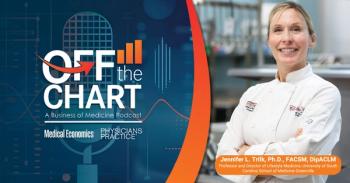
Practicing social distancing in the practice and more
Guidance from expert sources.
Physician practices should implement the Centers for Disease Control and Prevention’s
The waiting room is one area where social distancing should be exercised, she says.
Two strategies to enable social distancing in the waiting room are to limit the number of patients waiting at any given time and to ask patients’ family members to wait in the car or outside the practice. Strowhiro recommends telling patients about the second policy when the appointment is scheduled or by phone the day before their visit.
In addition, she advises physicians and other clinicians to observe a six-foot distance with patients. Still, Strowhiro admits that this isn’t always an option.
Trending:
Observing social distancing in the waiting room may require extending the hours of operation, which could be taxing on physicians and other clinicians, she admits. “You certainly have to balance the fact that physicians and clinicians can’t work 24 hours a day, which very well may require a reduction of patients per day.”
Tista Ghosh, MD, MPH, an epidemiologist and senior director of impact evaluation at San Francisco-based Grand Rounds, says practices should consider using telehealth to treat patients, which is another way to limit physical contact among patients and clinicians. In addition, some patients may have access to a virtual healthcare provider through their employer, adds Ghosh, who previously served as Colorado’s director of public health and chief medical officer.
While practices may have to navigate through employee wage and hour considerations, Strowhiro is strongly encouraging her clients to let most administrative and back-office employees work remotely.
Leveraging the practice’s virtual private network (VPN) is a must for remote employees, says Elizabeth Litten, a Princeton, N.J.-based healthcare attorney and HIPAA privacy and security officer at Fox Rothschild law firm. She also advises practices to provide remote employees with the tools they need, such as letting them take home a big monitor rather than having them work on a small laptop.
Mitigate risks associated with other building tenants
One concern for physician practices that are located in the same building as other businesses is the need to work with the landlord or property management company to reduce access to the building and increase awareness about the practice’s presence.
Rose Willis, JD, an attorney with Detroit-based law firm Dickinson Wright, says the practice administrator should coordinate with the landlord or the property management company if the office is located in a building that has more than one other tenant and shares a common area, such as a lobby or bathrooms.
Specifically, Willis recommends limiting the number of entrances to the building and assigning someone to capture the names and body temperatures of the people who enter the building. Practice administrators should also help increase signage to notify building visitors that there’s a physician practice in the building, in addition to coordinating with the building manager and other tenants on stepped-up cleaning protocols.
As more governors move to shut down non-essential business in their states and many employees are working from home, this is an issue physician practices may not have to deal with going forward, says Benjamin Widener, JD, an attorney and shareholder with Stark & Stark law firm in Lawrenceville, N.J.
Depending on the type of care they provide, practices will be impacted differently by their state governors’ mandates related to non-essential businesses. For example, in New Jersey, where Widener practices, all elective medical and dental procedures were cancelled as of March 27
Widener’s advice to physician practices? “Pay very close attention to the day-to-day shifts of the legal landscape on the federal level and the local level to see if there are any new orders or legislation that might impact their business.”
Read More:
Make thoughtful decisions to furlough or lay off employees
An outpatient cardiology practice Widener advises had to furlough some of its cardiologists. He says the practice has retained a few cardiologists who will visit patients in the hospital.
That’s just one of a handful of approaches a practice can take, according to Widener. Another option is to retain all employees and reduce everyone’s hours or reduce everyone’s pay. Alternatively, the practice can choose to reduce staff to only essential functions, which could include retaining a few doctors, in addition to a billing employee and the practice administrator.
Strowhiro says some of her physician practice clients are putting employees on a temporary leave of absence, which may or may not be paid. This approach works best, she explains, when team members understand that it can help sustain the practice and, hopefully, open with the same doctors and clinicians in the future.
With layoffs, specifically, Widener advises practices against making guarantees to employees that they will be hired back. In addition, practices have to decide about paying employees for unused vacation and sick time, he adds.
Communicating and being transparent with the methodology behind staff reductions is important, he adds. Team members should be told the reasons for the reductions. For example, everyone in the practice will notice they’re seeing 50% less patients this week than the previous week, and that means a reduction in revenue, he explains.
For additional guidance, physician practices can consult the American Academy of Family Physicians COVID-19 preparedness
Newsletter
Optimize your practice with the Physicians Practice newsletter, offering management pearls, leadership tips, and business strategies tailored for practice administrators and physicians of any specialty.












